What Is The Size Of A 33 Inch Tire
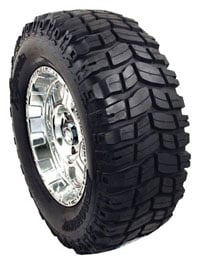
For nigh Jeepers, a tire upgrade is the biggest trail operation bang for the buildup dollars. It offers improvements in both vital trail performance parameters, traction, clearance, and just looks cool. To start, please refer to the Break Advisor for more tips on what tire sizes will fit on your Jeep. While you can become an improvement in performance from even a small-scale size upgrade, the benefits multiply equally you go bigger... within limits. In that location comes a place, and it varies from Jeep to Jeep, where the toll, complications and compromises have to exist very seriously considered and counterbalanced against your end utilize of your Jeep.
Your Jeep wheels carry you anywhere you desire to go, whether you're driving through town or off-road. Taking an off-road trip is exhilarating, merely having the right size tires is a necessity. Rough trails full of rocks and debris habiliment your tires down prematurely, but 4WD.com offers the high-quality parts yous need to keep having nifty off-road experiences.
Choose the Right Tire Size
Nil excites you more than than humid the balonies while you travel off road. When your tires chunk and you need to supplant them, choosing the right size is vital to improving your off-route experience. 4WD.com sells the perfect replacements. Whether you choose tires that measure out 33, 35 or 37 inches, you should choice a uniform rim. Rims accept guidelines every bit to which tire sizes they can exist used with effectively. These guidelines ensure that your Jeep wheels perform better when they are off-road.
Pick a Combo
When traveling off-road, yous want to be able to air-down for improve control, especially when traveling on rocky terrain. To increment performance, your tire should exist compatible with your rim size. 33-inch tires work well with rims that measure 15 or 16 inches in width, while 35-inch tires should only exist used with rims that are at to the lowest degree 17-inches wide. Larger tires require wider rims to maximize the tire contour and better your Jeep's maneuverability. 33-inch tires on xv-inch rims make a great combination because they requite your ride both flexibility and control, vital parts of off-roading.
Shop Confidently With Our Price Guarantee
At 4WD, nosotros are dedicated to helping jeepers find the highest quality parts at the all-time prices. Nosotros will happily price match and refund the difference if yous happen to find a meliorate price within ninety days of purchasing a Jeep part from us. We pride ourselves on providing first-class customer service and quality aftermarket parts. We know that we have the parts you need to beefiness up your ride, so don't wait any longer. Lodge from u.s.a. today.
Popular searches: jeep wrangler seats, jeep roof rack, jeep wrangler soft peak, jeep wrangler center console
Choosing a Tire and Cycle Combo
Every tire has a range of rim sizes that will offer the best performance and wear. The rim diameter is a given. A 15 inch tire has to go on a xv inch rim. Catamenia. With regards to width, the tire manufacturer list a range for a given tire. A 12.50-inch wide LT tire, for example, might show a range of approved rim widths from 8.5-xi inches. Some will bear witness a measuring rim width (MRW), which is the rim size used to obtain the department width specification. A narrower rim volition brand the tire narrower and a wider one will fatten it up a bit. A good dominion-of-thumb is that for every one-half-inch of rim width larger or smaller than the MRW, the section width will alter approximately a quarter inch. This tin be useful in plumbing fixtures a tire that near fits but rubs a little.
The ideal is to make the rim width equal to the MRW, where the manufacturer designed the tire to run. At to the lowest degree stay within the recommended width. If you lot don't, squirrelly handling and increased wear could result on the highway. A narrow rim tends to pull the edges of the tread upwardly and away from contact with the route. Too broad tends to make the tread pull up in the centre. On the trail, either of these extremes could brand the tire more vulnerable to rock damage or being rolled off the rim at low trail pressures.
Some Jeepers like to run at the minimum end of the width spec to assistance protect the rim on the trail. Others think the wider cease of the spec is amend as it lets the tire flex better. This is i of those controversies where both sides are correct... as long equally the rim is within the recommended width range.
Check out some of pinnacle selling wheel and tire combos to see what we mean:
Larger Diameter Rims
A recent trend... and a welcome one... is larger diameter 4x4 rims. You can now upgrade from 15 or 16 inch bore rims to 17, 18 or 20 inch rims. The pick of tires to fit these wheels is growing apace.
The particular advantage from such a tire/bicycle combo comes mostly in the street surface area. A 37 inch tire on a xv inch rim has a lot of tire profile (10-xi inches) between the contact patch and the rim. Even when aired up, that makes for a squirrelly tire because the tires tends to roll and flex when braking or cornering. 24-hour interval to day, with a careful, clued-in driver, that may be livable... except in unexpected emergency situations. The larger rims reduce that profile while keeping the aforementioned overall tire diameter and the result is ameliorate and more than predictable street handling. Many people think the profile of a 33 inch tire on a xv inch rim, approximately 8-9 inches, is the maximum profile for a tire used day to day on the street. If you run a tire bigger than 35 inches in diameter, you are most in need of a 17-20 inch rim.
The downsides are relatively minor and come up on the trail side of things. With the reduced air book of the lower profile tire, you may not be able to air down quite as much for the trail. Most Jeepers with dual-purpose street/trail machines detect it an easy compromise. The contour of a 33 offers enough of room for ambulation down to get the flex needed for hard 'wheeling. Only the most hardcore Jeepers needs more, and the odds are his rig isn't a daily commuter.
Come across Jeeper's favorite large bicycle and tire combos for some inspiration:
Tread Blueprint
This is one of your almost disquisitional choices. It will dictate street and trail operation, influence street fuel economy and change the tire wear equation for the better or worse. The chief pick involves evaluating your trail traction needs in the places y'all most frequently frequent and balancing them against your street driving needs.
Tread design can be broken upward into three very basic categories, the street tire, the all-terrain and the mudder. Four if you want to include the rockcrawling variations of the mudder. We won't talk about street tires at all, other than to say they do the all-time on the street if that'south what yous demand. In this instance, your 4x4 is likely an all-weather vehicle and you'd want to choose an all season street tire or even a snow rated tire.
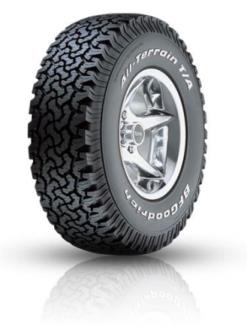
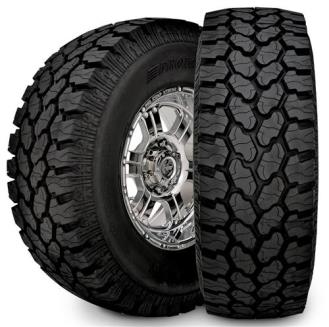
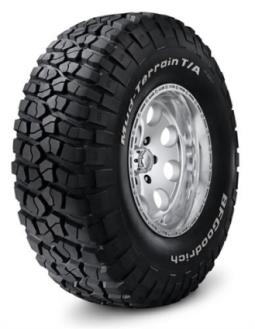
Mudders and Rock Tires
The more than aggressive the tread design, generally, the improve the trail performance. The open tread design of a mud or rock tire divides the tread into pocket-sized blocks, leaving many void areas. In mud this makes for a tire with lots of edges that work more or less like paddles. The void areas are open enough that the mud that collects in them tin be thrown out via centrifugal strength, leaving the tread blocks open to supply grip equally they rotate dorsum down into the goo.
On rocks, the blocks of tread are more than flexible to arrange to irregular surfaces and have many bitter edges with which to grip the surface. On top of that, the ground pressure level on these blocks of tread is high. In some cases, the weight of the Jeep is full-bodied on just a few of these tread blocks and are practically "glued" to the rock. What's the deviation between a mud and rock tire? Oftentimes very little if we are talking about radials. Nigh radial mudders perform very well in rocks. Not and so much the bias ply. The specialty rock tires differ from a truthful mudder in way the tread blocks are staggered and aligned and many times are directional. Ofttimes, the biggest difference is in the composition of the rubber. Dedicated rock tires frequently use a softer condom compound to offer improve grip. Grip volition be very much meliorate than a standard limerick just treadwear will be very much reduced when used on the street. Some rockcrawling tires as well use extra plies in the carcass to resist sidewall damage.
Aggressive tires accept downsides that appear by and large on the street. In the fuel economic system department, you may notice a small decrease considering they create more rolling resistance.
Treadwear will as well be reduced according to how aggressive the tread pattern and the rubber compound. They are frequently noisier besides, though modern tread design has greatly reduced that trend. Finally, street handling is reduced because of the deep, flexible tread designs. Choose a mudder or rack tire if trail performance is your almost important consideration.
All Terrains
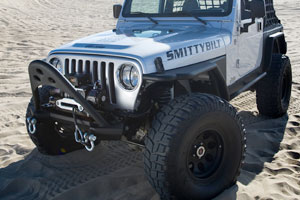
"All-Terrain" is a trademarked proper name used by BFG since the '70s but ane which has get a generic term for an all-around tire that does "OK" in all venues. In that location are more than and less ambitious ATs just if you discover yourself spending most of your fourth dimension on the street, or in relatively balmy trail situations, the all terrain will deliver better MPG and treadwear than a mudder, while offer better handling to boot. Ice and snow performance (on the street) is better every bit well. With less void area, the AT puts a bit more prophylactic to the ground than the MT simply the tread is more than stable and offers more predictable handling. ATs are also quieter than mudders.
On the trail, the ATs are at their worst in mud but are proficient to very good everywhere else. The more than open up tread AT designs tend to perform better in the clay and vice versa. The opposite is generally true on the street. Due to improvements in engineering science, the more open AT tread designs can do much better on the trail than ever before. Tread depth is still ordinarily less than a mudder, even on the more aggressive ATs, so they aren't quite as flexible in conforming to irregular surfaces. Most times, an AT will outperform an MT in sand. Few ATs will equal an MT in rocks, however. Choose an all-terrain if your Jeep gets a substantial corporeality of street miles or is used in winter climates that accept snowfall.
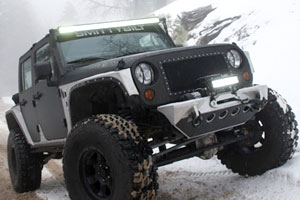
Speaking of snow, there are two tire ratings of interest to those in the snow belt. The first is the sometime "Mud and Snowfall" rating (Grand&Due south), which was basically the tire manufacturer saying, "Yeah, it's OK in the snowfall. Well, manifestly, that'due south open to some estimation. The more recent, and useful, rating is '99 upward Winter Tire Traction rating. These tires have to meet an actual winter tire operation standard and those that do are allowed to vesture a "snowflake on the mountain" symbol. Many all-flavor and some all-terrains carry this rating.
The Forgotten Tire
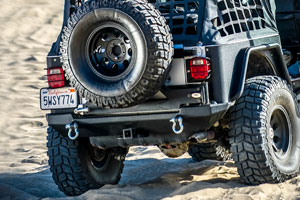
Any tire can be punctured or cut and so a good spare is a vital tool. "Anything that volition hold air," is the common cheapskate's credo. That's probably a workable philosophy on the street, where a few miles will conduct you lot to a tire shop. On the trail, replacing a grippy-but-deflated tire with a bald spare reduces your traction potential past as much as 25 percentage. Y'all then may struggle on the spots you would unremarkably ace. If the bore is different than the other tires, y'all could come across unequal and locker issues. An automatic locker goes positively nuts with two dissimilar diameter tires and may become cheerio-bye equally a event. Ouch! The best tip... have five identical tires and rims. Include the spare into the rotation process and you lot will be able to significantly extend the life of any prepare of tires.
Wheel Choices: Steel vs Alloy
Your 2 basic wheel choices are aluminum alloy or steel. Steel wheels are tough, malleable and relatively inexpensive, but heavy. Cast or forged alloy wheels are lighter, usually stronger than steel (especially forged) just non every bit malleable. The malleability aspect come into play when repairing a bent bike. Alloys are more than problematic to repair, though forged units tend to be more forgiving in that regard than cast.
Jeeper's Favorite Steel Wheels
The weight of the tire and wheel is the, "Grizzly in the outhouse," when it comes to tire choices. The increased rotational inertia of bigger tires and wheels puts a larger load on your brakes on the street and reduces treatment qualities. On the trail, that inertia adds to drivetrain loads and tin help suspension axle parts.
An "average" 33 inch tire weighs about 55 pounds. A stock 225/75-fifteen tire weighs 28 pounds. Aftermarket steel wheels are unremarkably heavier and stronger than the stock wheels. In averaging a few aftermarket 15x10 inch steel wheels, we'll use 26 pounds as a number versus near 16 for the stock cycle. Then, where the stock wheel and tire combo weighed 44 pounds, a 33 on a 15x10 steel is 81 pounds. An "average" cast alloy wheel (forged are a scrap lighter) come in at 16 pounds, dropping the upgraded tire and bike back downwardly to 71 pounds.
At that place are 2 basic types of alloy wheels to consider, forged and cast. There are besides modular wheels, which normally consist of a cast middle section with a spun aluminum rim. These wheels are way-weak for the trail, then avert them. In the cast realm, there are depression-pressure level bandage wheels and counter force per unit area, or "vacuum cast," wheels. The latter system results in a stronger cycle considering fewer impurities are introduced into the casting. Forged wheels are the strongest and lightest because the wheel are made from billet fabric that is rolled or pressed into shape by millions of pounds of pressure. This double forging makes the alloy stronger by tightening it'south grain structure.
Beadlocks... Or Not
Hardcore Jeepers that run extremely low trail tire pressures often find beadlocks necessary to avoid rolling the tire off the rim. Most beadlocks utilise a clamped on band on the outer bead to grip the tire. Others use an inflatable tube inside the tire (with a second valve stem) and some use a spacer that fits betwixt the beads.
You lot don't see many daily drivers with beadlocks. Part of that is the actress expense and function is the potential bug an owner may encounter. For a trail rig seldom driven on the street, these problems aren't an outcome, but for a daily driven, dual purpose auto, they may exist.
The first problem to note with most beadlocks is that they are heavier and much harder to get balanced than a standard wheel. Some owners report the clamping ring type beadlocks fail at high speed, causing sudden deflation and parts flying effectually the highway. In that location are a still a few practice-it-yourself beadlock kits out there that depend greatly on the skill of the welder/fabricator. Many, if not well-nigh, beadlock problems can be traced back to human error, either honest mistakes or inexcusable stupidity.
Careful owners report good service from well-nigh styles of beadlocks just, expense aside, the starting time choice is to evaluate your needs. If you are seldom in farthermost terrain, seldom aired downward to extreme levels and bulldoze your Jeep regularly on the street, why deal with the potential downsides? The inflatable beadlocks and the spacer styles, nevertheless, seem the most trouble costless in a daily commuter situation.
Backspace, Showtime
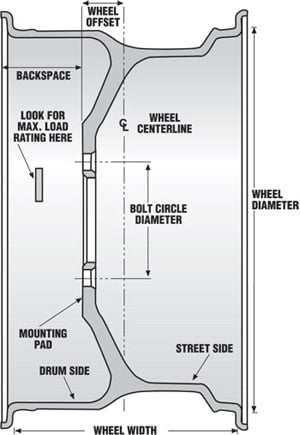
These are ii commonly mixed upwards terms. Backspace is the measurement between the wheel mounting flange and the inside border of the rim. Offset is the distance from the mounting flange to the exact centre of the wheel rim, dewdrop to bead. If the wheel centerline is offset to the outside (away from the axle), the mounting flange moves to the inside and the wheel has negative offset. If the centerline is to the inside, the bicycle flange moves outboard and it's called positive offset.
You can determine offset by measuring backspace, subtracting that dimension from the rim width and and so dividing by two. An 8 inch rim with 5.5-inch backspacing has a 1.25-inch start (8.0-v.5=2.five/2=1.25-inches). Recall that rim width is technically from bead to bead, not between the outer edges of the rim.
A bigger tire almost always comes with an upgrade to a wider rim. Near times the extra width will be added equally to the inside and exterior. That keeps the load on the bike bearings in the place where the factory intended. A stock 7 inch rim with 3-1/2 inch backspace might be replaced by an 8-inch rim with 3-/three/4 inch backspace. One-half an inch is added to the within and the other half-inch to the outside. How much y'all tin can add together to the inside can become a problem on the front, which has to steer, so in some cases, more of the extra width is added to the outside edge, for case, an 8-ane/2 inch rim with 3-3/4 inch backspace that has an inch added to the outside. Adding to much to the inside can go an issue in the front since that is how you steer. In some cases, calculation actress width to the exterior border makes sense. For instance, an 8-1/2 inch rim with 3-34 inch dorsum space will have an inch added to the outside. That keeps the backspace the aforementioned merely changes the offset. Changing the offset a great deal in either direction can cause early bicycle bearing failure and tire wear issues.
Bolt Pattern
Many Jeeps use a small 5 on 4.5-inch design. This is fine until you get into large bore tires. Big and tall tires will focus a lot of stress and strain over that fairly small area which results in some major trouble. It tin appear in the form of broken wheel studs, bent wheel flanges, impairment to the wheel at the mounting points, amid other things. Many experienced hardcore Jeepers think the 35 inch tires are the betoken where nearly consider an upgrade to a 5 on v.5 inch pattern. Tires over 35 inches, especially on a hard worked Jeep, brand an upgrade fifty-fifty more than necessary. Since hub conversions are generally an aftermarket production that's of college quality than the OE piece, you terminate upward stronger in more ways than just the wheel flange. Eliminating the unit begetting hub constitute in XJs, YJs and TJs offers ane less weak link to offer up as tribute to the Trail Gods. In some cases, you lot can include a total-bladder conversion to the rear beam.
Cycle Spacers/Adapters
A spacer is sometimes necessary to cure small fitment issues where the alternative is prohibitively expensive. A common example is to correct the offset or backspace of a wheel and tire that'southward touching where it shouldn't. When kept within an inch, that'southward an OK pick. Keep in mind that the bolts holding the adapter to the hub, which prevarication unseen under the bicycle, tin can piece of work loose if not properly torqued and regularly checked! Check them a few times later on mounting the adapter. Apply spacers every bit a modest cosmetic device, not so y'all can apply totally unsuitable wheels. A quality spacer or adapter is usually made of billet aluminum and pretty stiff but spacing a wheel out some ridiculous amount is potentially dangerous.
Tech Tip: Finding Street Pressure level For Larger Tires
When you increase the tire size, those factory pressure recommendations go right out the window. If your stock 225/75R-15 tire had a 29 psi street rating, the 31x10.50 you replaced information technology with might need just 22psi to bear the same load. You demand a sure volume of air to support a given amount of weight, regardless of the tire size. When you take to carry that weight on a pocket-sized tire with a small-scale internal volume, you lot have to really pack it in and this increases pressure level. Putting the aforementioned volume of air into a larger tire, which has more internal book, creates less pressure only information technology carries the same weight.
A typical 35 10 12.50-xv might show a maximum load rating of 2550 pounds at 35 psi. That ways at 35 psi, those four tires can behave 10,200 pounds, or 5,100 pounds a pair. Your Jeep weighs 4,500 pounds. How much force per unit area do y'all need again? At that place are many ways of finding the new street force per unit area for a new set of large tires. All involve some trial and error. Here's i way.
Stride one is to become your Jeep weighed so you get the forepart and rear weight separately. Load the Jeep equally it'due south well-nigh oft driven, including a full tank of fuel and you. If you lot want to factor in some different scenarios, weigh it light and so with a chapters load. You can get a vehicle weighed in a variety of places, including the local landfill, grain elevators, scrapyards, and truck scales. Once you accept forepart and rear weights, y'all need to run into the manufacturer's load vs inflation charts for the exact tire you are using. The tire shop volition probably take this information, or can get it from the manufacturer.
Get-go, divide the weight at each finish past ii to go the individual weight on each tire. Take the per-tire weight and match information technology to the chart the go the pressure level yous need for that weight. If the pounds don't lucifer exactly, motion up to the next higher pressure. These load vs inflation charts volition expect like the 1 in the sidebar, which is a generic version for some popular tire sizes from the Tire & Rim Association.
You probable won't counterbalance side to side but if you did, you might find the tire on one side is loaded more than than the other. You can compensate by measuring the tire profiles and adding pressure to the depression side until information technology equals the high one. Take the measurements on flat ground and on smooth concrete. Forepart and rear weight, and therefore pressure, will also be different considering on end of the vehicle is near always heavier than the other.
The concluding cheque is the rut test. All tires generate a sure amount of rut running downward the highway and this oestrus will raise the tire pressure somewhat. This is normal. Pressure too low volition generate more than heat than normal. Check for this past measuring tire pressure later on a short, loftier speed run.
You already have your cold pressures. Take a 15 mile run at highway speeds (55mph and upward, but within the speed limit), stop and measure the tire pressure. If you live in a particularly hot area, exercise this in the morning before the pavement is blistering hot from the sun. If you live in a cold surface area, practice the exam in the warmer office of the mean solar day or wait for warm weather. Pull over in a safety spot and immediately measure the hot tire pressures. They should be about x percentage higher than the cold pressures. If they are college, add a few pounds of air to each pair (front or rear), allow the tires absurd and repeat until you lot get the correct results.
Tire Load vs Inflation Charts*
Each tire is rated differently by manufacturer for maximum load at a given maximum aggrandizement but this chart will requite you a general idea of how much weight a given size tire volition conduct at a lower inflation.
| Radial Tire Load (lbs.) vs Inflation (PSI) Charts | ||||||
|---|---|---|---|---|---|---|
| Tire Size | 25PSI | 30PSI | 35PSI | 40PSI | 45PSI | 50PSI |
| 30/nine.50-15LT | 1240 | 1410 | 1570 | 1715 | 1855 | 1990 |
| 33/9.l-15LT | 1565 | 1780 | 1980 | 2170 | 2345 | 2510 |
| 31/ten.50-15LT | 1400 | 1595 | 1775 | 1945 | 2100 | 2250 |
| 32/11.50-15LT | 1575 | 1795 | 1995 | 2185 | 2360 | 2530 |
| 33/12.50-15LT | 1765 | 2000 | 2225 | |||
| 35/12.50-15LT | 2015 | 2295 | 2555 | |||
What Is The Size Of A 33 Inch Tire,
Source: https://www.4wd.com/article/content.jsp?childEventId=jeep-advisors-tire-wheel-advisor
Posted by: penachem1942.blogspot.com


0 Response to "What Is The Size Of A 33 Inch Tire"
Post a Comment